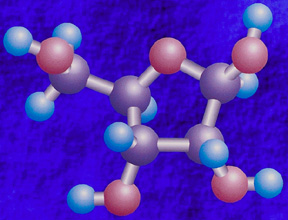Coacervates
Complex molecules such as the one pictured here came together to form coacervates
Click on image for full size
Corel Photography
In the warm primordial ocean, aggregates of amino acids, proteins, and other hydrocarbons came together into a form called *coacervates*. Amino acids will spontaneously form coacervates in the same way that beads of vinegar in oil come together. The Miller-Urey experiment showed that amino acids form under conditions similar to the Earth's primordial environment.
Click on image for full size
Corel Photography
These beads, or coacervates are perhaps the simplest of systems that, without a membrane, can be said to be bound together; that is they have a distinct inside and outside. The primordial ocean provided an ideal medium for their formation, for the primordial ocean was large, and water can hold the coacervates suspended for a long period of time without being disturbed.
It is not known whether these coacervates were life-like or not. Recall that life must be able to feed and reproduce itself.
The earliest life was probably much like coacervates however, and scientists think that this early life probably used a chemical process to process naturally produced organic compounds from the early ocean for food.

